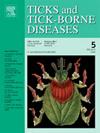在蒙古东部的Khalkh Numrug盆地首次记录到中国血蜱(蜱螨目:伊蚊科)
IF 3.4
2区 医学
Q2 INFECTIOUS DISEASES
引用次数: 0
摘要
蒙古对血蜱(蜱螨属:伊蚊科)的研究仍然很少。本文报道了蒙古国东部多诺德省努鲁格严格保护区首次确认的coninna Koch血蜱,1844,基于形态特征和分子分析。该地区位于蒙中边境,位于大兴安岭西部的森林草原和草原地带。在4月初至8月中旬的三年时间里,在六个地点(湖岸、河岸和沼泽森林)进行了蜱虫取样。共采集标本1014只,选取148只(含2只若虫)进行DNA提取。对线粒体16S rRNA (~ 455 bp)和Cox1 (~ 820 bp)基因进行PCR扩增。对8个样本进行测序,其中3个16S序列和2个Cox1序列符合质量阈值。这两个基因序列分别与来自俄罗斯的H. concina序列(Cox1: PP851089.1, PP851095.1;16S rRNA: KP866207.1)和中国(Cox1: KR108863.1;16S rRNA: ON097130.1),可在GenBank中找到。这种高水平的序列同一性有力地支持了蒙古样品为红毛猴的鉴定。与已发表的成蜱描述一致的形态特征进一步支持了物种鉴定。来自Khalkh Numrug盆地的这一记录代表了蒙古东部首次证实的H. concina的出现。这些发现强调需要进一步研究该物种的生态、宿主范围和潜在的公共卫生意义。本文章由计算机程序翻译,如有差异,请以英文原文为准。
First record of Haemaphysalis concinna (Acari: Ixodidae) tick in the Khalkh Numrug basin of Eastern Mongolia
Haemaphysalis (Acari: Ixodidae) ticks remain poorly studied in Mongolia. Here, we report the first confirmed record of Haemaphysalis concinna Koch, 1844 in the Numrug Strictly Protected Area, Dornod Province, eastern Mongolia, based on both morphological characteristics and molecular analyses. This region lies along the Mongolia-China border within the forest-steppe and steppe zones of the western Greater Khingan Mountains. Tick sampling was conducted at six sites (lakeshores, riverbanks, and marshy forests) between early April and mid-August over a three-year period.
A total of 1014 H concinna specimens were collected, of which 148 (including two nymphs) were selected for DNA extraction. PCR amplifications targeting the mitochondrial 16S rRNA (∼455 bp) and Cox1 (∼820 bp) genes were performed. Eight samples were sequenced, with three 16S and two Cox1 sequences meeting quality thresholds. The sequences of both genes exhibited 99.8 % and 100 % identity, respectively, to H. concinna sequences from Russia (Cox1: PP851089.1, PP851095.1; 16S rRNA: KP866207.1) and China (Cox1: KR108863.1; 16S rRNA: ON097130.1) available in GenBank. This high level of sequence identity strongly supports the identification of the Mongolian samples as H. concinna. Species identification was further supported by morphological characteristics consistent with published descriptions of adult ticks. This record from the Khalkh Numrug basin represents the first verified occurrence of H. concinna in eastern Mongolia. These findings underscore the need for further research on the species’ ecology, host range, and potential public health significance in the region.
求助全文
通过发布文献求助,成功后即可免费获取论文全文。
去求助
来源期刊

Ticks and Tick-borne Diseases
INFECTIOUS DISEASES-MICROBIOLOGY
CiteScore
6.90
自引率
12.50%
发文量
185
审稿时长
6-12 weeks
期刊介绍:
Ticks and Tick-borne Diseases is an international, peer-reviewed scientific journal. It publishes original research papers, short communications, state-of-the-art mini-reviews, letters to the editor, clinical-case studies, announcements of pertinent international meetings, and editorials.
The journal covers a broad spectrum and brings together various disciplines, for example, zoology, microbiology, molecular biology, genetics, mathematical modelling, veterinary and human medicine. Multidisciplinary approaches and the use of conventional and novel methods/methodologies (in the field and in the laboratory) are crucial for deeper understanding of the natural processes and human behaviour/activities that result in human or animal diseases and in economic effects of ticks and tick-borne pathogens. Such understanding is essential for management of tick populations and tick-borne diseases in an effective and environmentally acceptable manner.
 求助内容:
求助内容: 应助结果提醒方式:
应助结果提醒方式:


